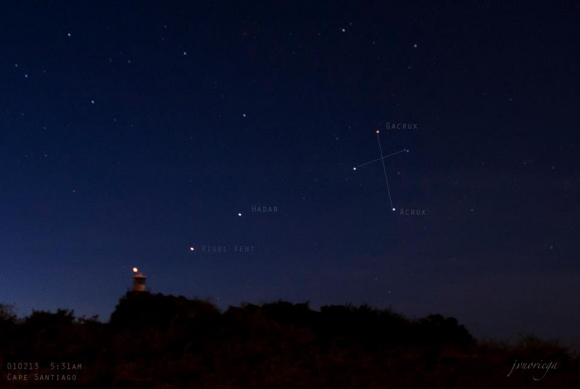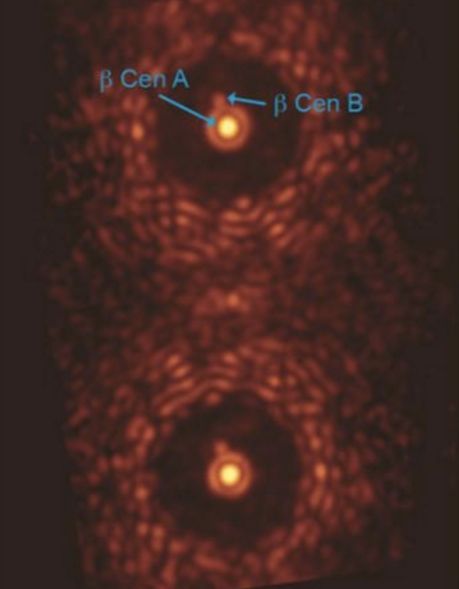

View at EarthSky Community Photos. | Dr Ski in Valencia, Philippines, captured the Southern Pointer Stars – Alpha Centauri (far left) and Beta Centauri – aimed at Crux, aka the Southern Cross. He wrote: “When you see the Southern Cross for the first time, you understand now why you came this way. – CS&N.” Thanks, Dr Ski!
One famous southern luminary is the star Hadar or Beta Centauri; we’ll use those names interchangeably in this post, as most astronomers do. Hadar is the 11th brightest star visible in Earth’s skies. It’s more famous than it might be otherwise for its location on our sky’s dome right next to Alpha Centauri, the fourth brightest star and closest star system to Earth.
Alas, neither Alpha Centauri nor Hadar (Beta Centauri) can be seen at all in the U.S. except very briefly from South Texas, parts of Florida and Hawaii. Meanwhile, Beta Centauri is very prominent as seen in Earth’s Southern Hemisphere. It’s bluish in color, and bright (magnitude 0.61).
Alpha and Beta Centauri are the southernmost bright stars in the fairly large and sprawling constellation of Centaurus the Centaur. Both are near the famed Southern Cross, and all are roughly 30 degrees from the south celestial pole.
Alpha Centauri and Beta Centauri (Hadar) are sometimes called the Southern Pointer Stars. They point to the Southern Cross. The Southern Cross is distinctive in its own right, but, if you’re in the Southern Hemisphere and want to be sure you’ve found the Cross, these two stars can help you.

If you are in the Southern Hemisphere, you can identify Alpha Centauri using the Southern Cross as a guide. A line drawn through the crossbar of the Cross, eastward, first comes to Hadar (Beta Centauri), then Alpha Centauri. Image via AstroBob.
Meanwhile, for northern observers, there really are no good pointer stars to Alpha Centauri and Hadar. If you live far enough south to see them, you will need to look for them low on the southern horizon at exactly the right time. The right time might come, for example, at roughly 1 a.m. (local daylight saving time) in early May.
By early July, Hadar culminates (reaches its highest point) in the south by nightfall.
It also can be seen briefly in the predawn spring skies.
At any of these times, if you are a Northern Hemisphere observer at a latitude like that of the southernmost U.S., you might be able to glimpse Hadar making a tiny arc across your southern sky.

View larger. | Photo of the stars Hadar and Rigel Kentaurus (Alpha Centauri) to the left of the Southern Cross via Jv Noriega from Cape Santiago, Philippines.
Hadar’s history and mythology. The proper name of this star – Hadar – apparently derives from an Arabic word for ground, possibly referring to its nearness to the horizon as seen from low latitudes. Richard Hinckley Allen of the classic book Star Names: Their Lore and Meaning reports that other stars in Centaurus, including Alpha, may also have carried this title.
Beta Centauri is also sometimes called Agena (derived from Latin words for the knee), obviously referring to the anatomy of its classical depiction.
The Centaur itself was supposed to be the son of the god Chronos and a sea nymph. Uncharacteristically wise and just, this centaur, often known as Chiron, was a favorite of Apollo and Diana and figures in some minor mythology of its own. Alpha and Beta Centauri share little in the classical mythology, although were often considered together. In Africa they were named for two men who once were lions, and in Australian aboriginal myths they represented two brothers who hunted and killed a large emu called Tchingal. At one time in China they were known, according to Allen, as Ma Wei, the Horse’s Tail.
The flag of Australia contains the Southern Cross as well as an additional bright star placed in the approximate position of Beta Centauri. However, the star is intended to represent the Australian Commonwealth Star rather than either Alpha or Beta Centauri.

This is a double image of the star Beta Centauri taken through an experimental coronagraph. Both images of the star contain a dark region that covers the complete 360 degrees around the central star. In both cases, the binary companion to Beta Centauri is easily detected. Image via Leiden University, University of Arizona.
Hadar science. Beta Centauri is not one star, but three. About a second of arc away, the companion star Beta Centauri B poses a difficult telescopic sight. Analysis of the light from Beta Centauri B reveals that it is a very close binary star. Thus the star seen as a single point of light to the human eye is in fact triple.
Hadar itself (Beta Centauri A) is a pair of B-class stars. The two stars have nearly identical masses and orbit each other over a period of 357 days. They are separated by a mean distance of roughly four astronomical units, that is, by four Earth-sun distances.
Meanwhile, about 100 Earth-sun distances away is Beta Centauri B (aka Hadar B).
The two stars of Beta Centauri A are very hot and very large. Both are giant stars, not main sequence stars like our sun. Giants and supergiants have left the main sequence, and have entered into the terminal stages of star-life. These stars may still have tens of millions of years left, but this is short by comparison to the billions of years a star like the sun spends in its adult life – that is, its life classified as a main sequence star.
Both stars we see as Beta Centauri A will likely someday explode as supernovae.
The three stars in the Beta Centauri system lie at a distance of about 400 light-years. When the two stars in Beta Centauri A binary do someday go supernova, they will be considered nearby supernovae.
Beta Centauri’s position is RA:14h 03m 49s, dec:-60° 22′ 23″.
Bottom line: Hadar, aka Beta Centauri, joins Alpha Centauri in pointing to the Southern Cross. It’s a triple system. Two of its stars will someday become nearby supernovae.
from EarthSky http://bit.ly/2Ufxwm9


View at EarthSky Community Photos. | Dr Ski in Valencia, Philippines, captured the Southern Pointer Stars – Alpha Centauri (far left) and Beta Centauri – aimed at Crux, aka the Southern Cross. He wrote: “When you see the Southern Cross for the first time, you understand now why you came this way. – CS&N.” Thanks, Dr Ski!
One famous southern luminary is the star Hadar or Beta Centauri; we’ll use those names interchangeably in this post, as most astronomers do. Hadar is the 11th brightest star visible in Earth’s skies. It’s more famous than it might be otherwise for its location on our sky’s dome right next to Alpha Centauri, the fourth brightest star and closest star system to Earth.
Alas, neither Alpha Centauri nor Hadar (Beta Centauri) can be seen at all in the U.S. except very briefly from South Texas, parts of Florida and Hawaii. Meanwhile, Beta Centauri is very prominent as seen in Earth’s Southern Hemisphere. It’s bluish in color, and bright (magnitude 0.61).
Alpha and Beta Centauri are the southernmost bright stars in the fairly large and sprawling constellation of Centaurus the Centaur. Both are near the famed Southern Cross, and all are roughly 30 degrees from the south celestial pole.
Alpha Centauri and Beta Centauri (Hadar) are sometimes called the Southern Pointer Stars. They point to the Southern Cross. The Southern Cross is distinctive in its own right, but, if you’re in the Southern Hemisphere and want to be sure you’ve found the Cross, these two stars can help you.

If you are in the Southern Hemisphere, you can identify Alpha Centauri using the Southern Cross as a guide. A line drawn through the crossbar of the Cross, eastward, first comes to Hadar (Beta Centauri), then Alpha Centauri. Image via AstroBob.
Meanwhile, for northern observers, there really are no good pointer stars to Alpha Centauri and Hadar. If you live far enough south to see them, you will need to look for them low on the southern horizon at exactly the right time. The right time might come, for example, at roughly 1 a.m. (local daylight saving time) in early May.
By early July, Hadar culminates (reaches its highest point) in the south by nightfall.
It also can be seen briefly in the predawn spring skies.
At any of these times, if you are a Northern Hemisphere observer at a latitude like that of the southernmost U.S., you might be able to glimpse Hadar making a tiny arc across your southern sky.

View larger. | Photo of the stars Hadar and Rigel Kentaurus (Alpha Centauri) to the left of the Southern Cross via Jv Noriega from Cape Santiago, Philippines.
Hadar’s history and mythology. The proper name of this star – Hadar – apparently derives from an Arabic word for ground, possibly referring to its nearness to the horizon as seen from low latitudes. Richard Hinckley Allen of the classic book Star Names: Their Lore and Meaning reports that other stars in Centaurus, including Alpha, may also have carried this title.
Beta Centauri is also sometimes called Agena (derived from Latin words for the knee), obviously referring to the anatomy of its classical depiction.
The Centaur itself was supposed to be the son of the god Chronos and a sea nymph. Uncharacteristically wise and just, this centaur, often known as Chiron, was a favorite of Apollo and Diana and figures in some minor mythology of its own. Alpha and Beta Centauri share little in the classical mythology, although were often considered together. In Africa they were named for two men who once were lions, and in Australian aboriginal myths they represented two brothers who hunted and killed a large emu called Tchingal. At one time in China they were known, according to Allen, as Ma Wei, the Horse’s Tail.
The flag of Australia contains the Southern Cross as well as an additional bright star placed in the approximate position of Beta Centauri. However, the star is intended to represent the Australian Commonwealth Star rather than either Alpha or Beta Centauri.

This is a double image of the star Beta Centauri taken through an experimental coronagraph. Both images of the star contain a dark region that covers the complete 360 degrees around the central star. In both cases, the binary companion to Beta Centauri is easily detected. Image via Leiden University, University of Arizona.
Hadar science. Beta Centauri is not one star, but three. About a second of arc away, the companion star Beta Centauri B poses a difficult telescopic sight. Analysis of the light from Beta Centauri B reveals that it is a very close binary star. Thus the star seen as a single point of light to the human eye is in fact triple.
Hadar itself (Beta Centauri A) is a pair of B-class stars. The two stars have nearly identical masses and orbit each other over a period of 357 days. They are separated by a mean distance of roughly four astronomical units, that is, by four Earth-sun distances.
Meanwhile, about 100 Earth-sun distances away is Beta Centauri B (aka Hadar B).
The two stars of Beta Centauri A are very hot and very large. Both are giant stars, not main sequence stars like our sun. Giants and supergiants have left the main sequence, and have entered into the terminal stages of star-life. These stars may still have tens of millions of years left, but this is short by comparison to the billions of years a star like the sun spends in its adult life – that is, its life classified as a main sequence star.
Both stars we see as Beta Centauri A will likely someday explode as supernovae.
The three stars in the Beta Centauri system lie at a distance of about 400 light-years. When the two stars in Beta Centauri A binary do someday go supernova, they will be considered nearby supernovae.
Beta Centauri’s position is RA:14h 03m 49s, dec:-60° 22′ 23″.
Bottom line: Hadar, aka Beta Centauri, joins Alpha Centauri in pointing to the Southern Cross. It’s a triple system. Two of its stars will someday become nearby supernovae.
from EarthSky http://bit.ly/2Ufxwm9

Aucun commentaire:
Enregistrer un commentaire